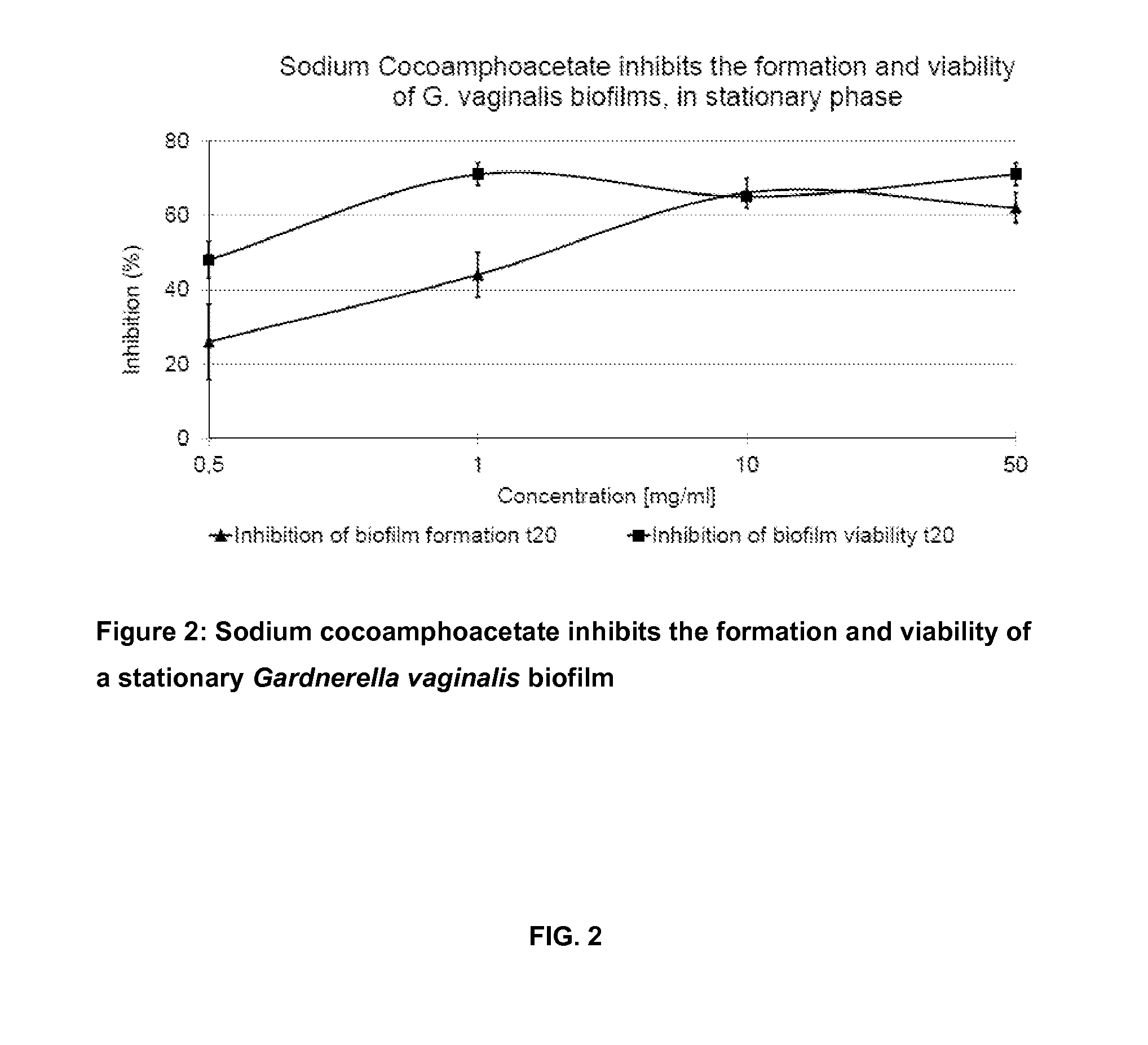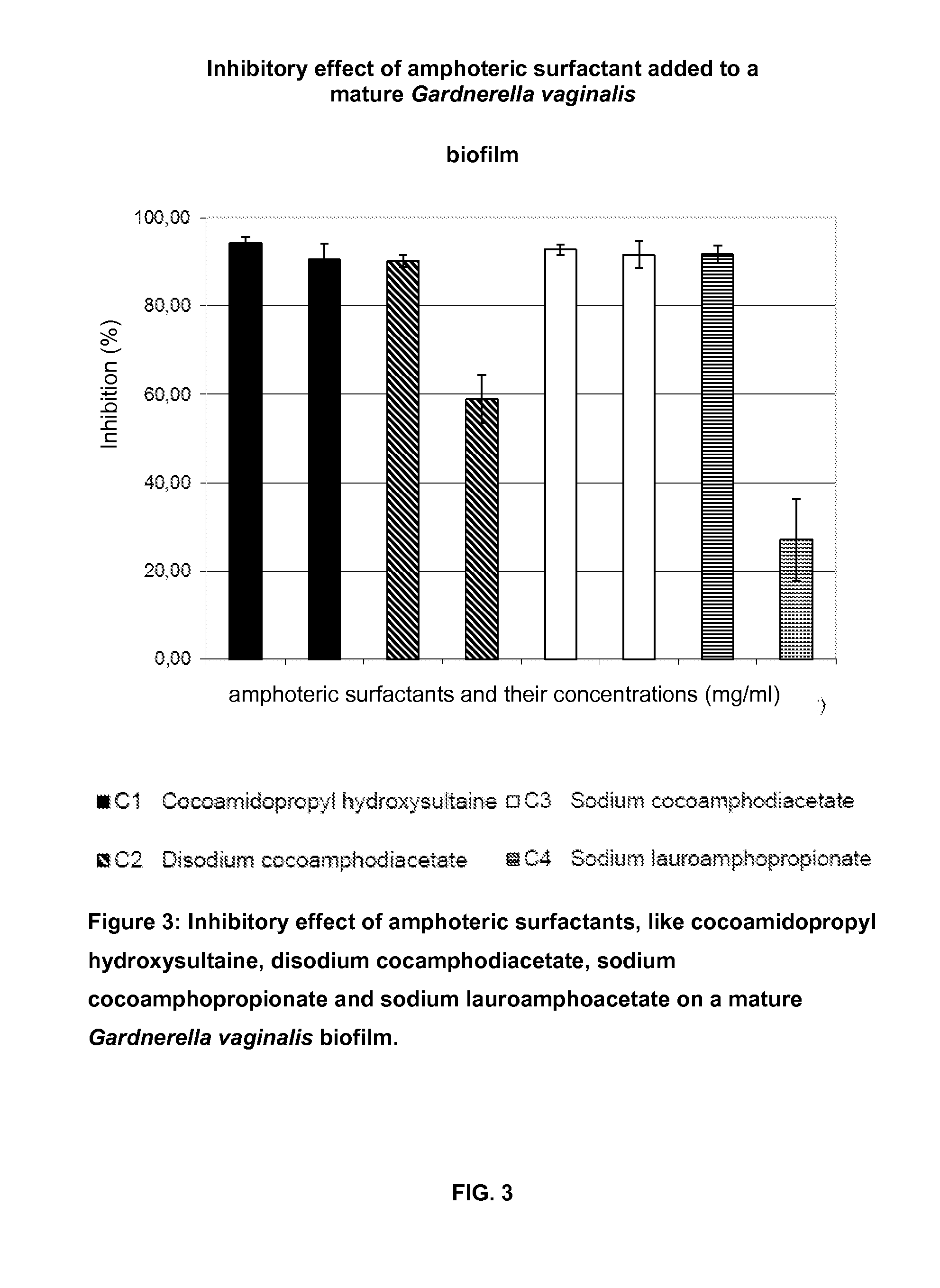Use of amphoteric surfactants for the prevention and treatment of pathogenic vaginal biofilms in vaginal infections
a technology of amphoteric surfactants and vaginal infections, which is applied in the direction of biocide, plant growth regulators, animal husbandry, etc., to achieve the effect of effectively eradicating and/or treating the formation of vaginal infections
- Summary
- Abstract
- Description
- Claims
- Application Information
AI Technical Summary
Benefits of technology
Problems solved by technology
Method used
Image
Examples
example 1
Inhibition of G. vaginalis Biofilm Formation and Viability by Sodium Cocoamphoacetate in Forming as Well as Well Developed but Still Growing G. vaginalis Biofilms
[0053]The inhibitory effect of amphoteric surfactants on the formation of Gardnerella vaginalis biofilms were tested in biofilms, grown in 96 well tissue culture test plates. Before starting the biofilm experiments, MIC (minimal inhibitory concentration) values for sodium cocoamphoacetate for planktonic growing Gardnerella vaginalis cultures were determined MIC values for sodium cocoamphoacetate against Gardnerella vaginalis had not been reported so far.
[0054]Gardnerella vaginalis (strain ATCC 14018) were grown on Columbia agar plates supplemented with 5% sheep blood, liquid cultures were grown in brain heart infusion broth supplemented with 2% (w / v) gelatine, 0.5% yeast extract, 0.1% starch and 1% D-(+)-glucose at 37° C. and with the addition of 5% CO2.
[0055]For a preculture, bacteria were inoculated...
example 2
Inhibition of Stationary Gardnerella vaginalis Biofilms by Sodium Cocoamphoacetate
[0068]To determine how different concentrations of sodium cocoamphoacetate damage well formed biofilms in the stationary phase, compounds were added in PBS buffer to 20 hours old biofilms and analyzed after further 20 hours of incubation by determining their biomass and viability.
B) Inhibition of a Gardnerella vaginalis Biofilm in the Stationary Phase
[0069]FIG. 2 illustrates that sodium cocoamphoacetate influences / inhibits both the formation and the viability of Gardnerella vaginalis biofilms in the stationary phase.
[0070]Bacterial biofilms in stationary phase are known to be highly resistant to antibiotic treatments.
[0071]Sodium cocoamphoacetate was tested for its ability to inhibit formation and viability of Gardnerella vaginalis biofilms in the stationary phase as well. Surprisingly, the addition of sodium cocoamphoacetate in concentrations from 1 mg / ml to 50 mg / ml (that means...
example 3
Inhibition of Gardnerella vaginalis Biofilm by Further Amphoteric Surfactants
[0073]The tested substances namely cocoamidopropyl hydroxysultaine, disodium cocamphodiacetate, sodium cocoamphopropionate and sodium lauroamphoacetate were dissolved in fresh media and added to a mature G. vaginalis biofilm (t20m, see Example 1). After another 20 hrs of incubation, the biofilm viability was determined via Live / Dead staining, as described above.
[0074]The used compounds were added in several concentrations, whereas only two different concentrations per compound are shown in FIG. 3.
[0075]It was surprisingly found that the added amphoteric surfactants also inhibited the biofilm formation and the cell viability in well developed and still growing biofilms. In particular cocoamidopropyl hydroxysultaine and sodium cocoamphopropionate are good candidates, because even low concentrations (0.14 mg / ml and 0.16 mg / ml respectively) can inhibit the biofilm viability up to 90%.
[0076]Summarizing all given...
PUM
| Property | Measurement | Unit |
|---|---|---|
| Weight | aaaaa | aaaaa |
| Amphoteric | aaaaa | aaaaa |
Abstract
Description
Claims
Application Information
 Login to View More
Login to View More - R&D
- Intellectual Property
- Life Sciences
- Materials
- Tech Scout
- Unparalleled Data Quality
- Higher Quality Content
- 60% Fewer Hallucinations
Browse by: Latest US Patents, China's latest patents, Technical Efficacy Thesaurus, Application Domain, Technology Topic, Popular Technical Reports.
© 2025 PatSnap. All rights reserved.Legal|Privacy policy|Modern Slavery Act Transparency Statement|Sitemap|About US| Contact US: help@patsnap.com



